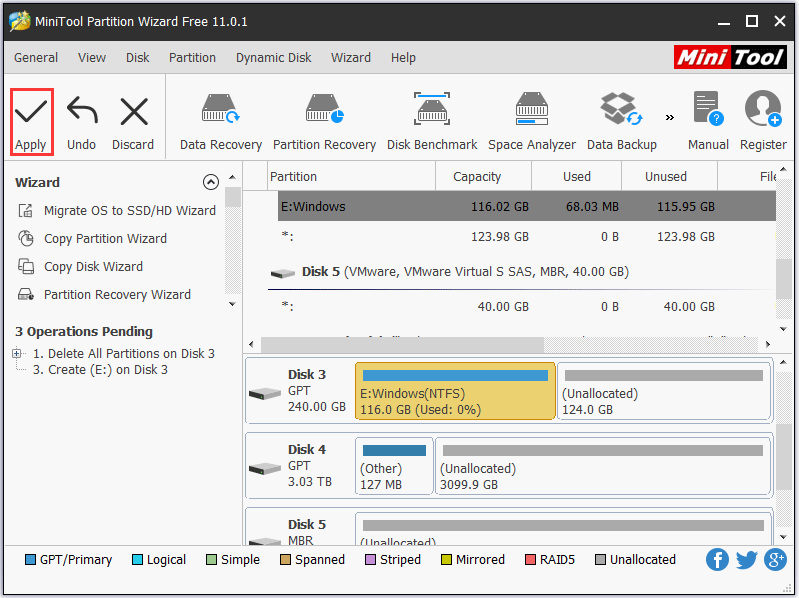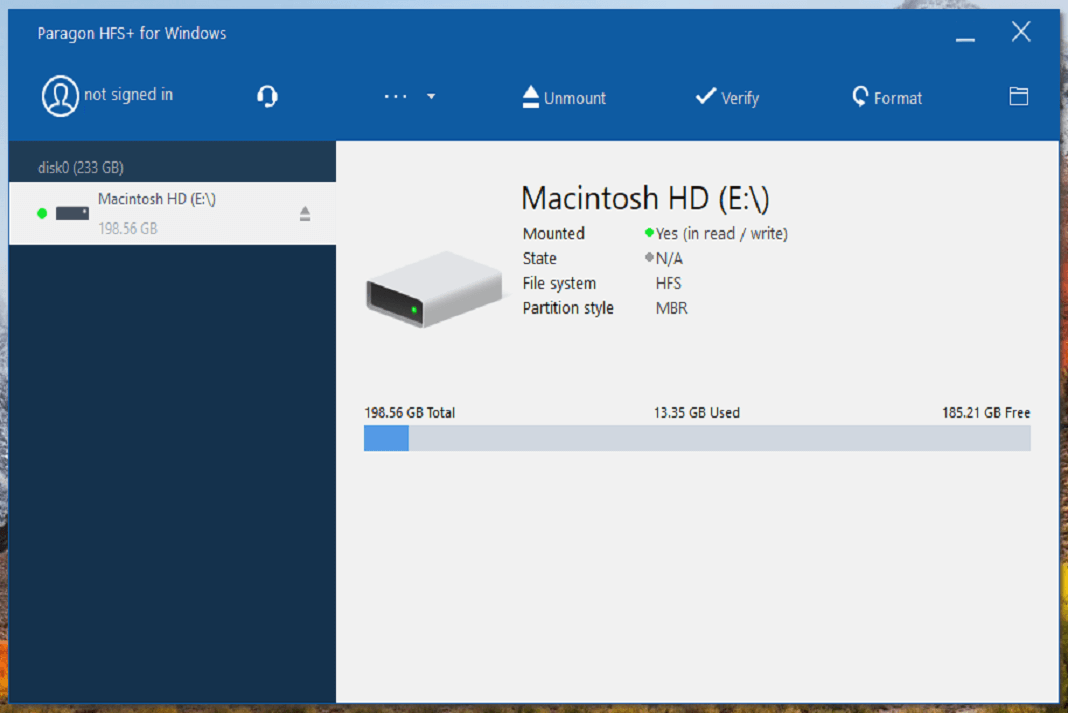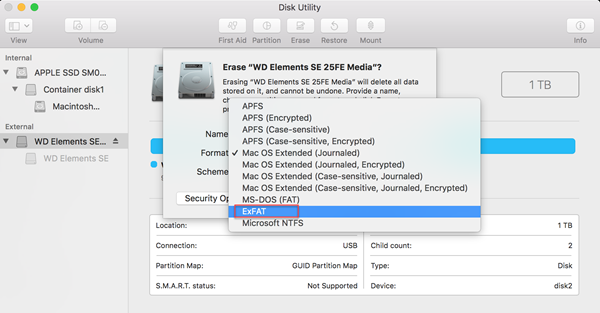Dec 02, 2019 USB drives and external hard drives use the Windows FAT32 to format for compatibility. The best news is that most devices included Mac computers can read and write from FAT32 devices. New Apple devices will be formatted with APFS while old Mac drives can use the HFS file system. However, Windows by default can’t read these file systems. Aug 28, 2020 What’s the FAT32 system on Mac? The configuration of hard drives in MAC is different From Windows. Mac basically uses HFS+ but also supports FAT32. This FAT32 system on MAC is used for storage media, such as memory cards, flash drives, and also external hard drives.
- Mac OS Extended (HFS+): the native hard drive file system for Mac. Windows users can read and write to HFS+ (journaled) hard drives by installing the Paragon driver for Mac. ExFAT: generally compatible with Mac and Windows. ExFAT is not a journaled file system which means it can be more susceptible to data corruption when errors occur or the.
- I used Fat32 on an external disk for my MBA and am not impressed that file sizes are limited to 4GB max. Thus exFat looks more appealing. Does HFS perform much better under MacOS with respect to access time and transfer speed? Finally, would using exfat help me avoid partitioning my internal SSD between Mac OS and Windows?
Nowadays, when you buy a USB drive, you can use it right out of the box with your Mac. However, unless it’s been designed for use with a Mac, it won’t be formatted using macOS’ preferred file system (either Mac OS Extended or APFS, depending on which version of macOS you’re running).
That’s because most of the computers in the world run Windows, and Windows uses a different file system, usually one known as Fat32. Drives formatted as Fat32 can be read from and written to by macOS, but it’s not optimal and you’re more likely to run into problems than if you use macOS’ native format. So, if you’ve bought a USB drive that’s formatted as Fat32, or any other format other than Mac OS Extended (also known as HFS+) or APFS, here’s how to format a USB drive on Mac. It’s exactly the same procedure if you need to reformat a flash drive on a Mac.
How to format a USB drive on a Mac
1. Plug the drive into a USB socket (if you have a recent MacBook or MacBook Pro that only has USB-C connectors, you’ll need a USB-C to USB-A adaptor).
2. Open a new Finder window and click on the drive. Make sure it has no files on it that you need. The process of reformatting it will wipe all the data from it.
3. Once you’ve copied any files you need from the USB drive to your Mac, go to Applications>Utilities and double-click on Disk Utility.
4. Click on the USB drive in the sidebar and then choose Erase from the toolbar at the top of the window.
5. In the window that drops down type a name for the formatted drive in the box next to Name.
6. Choose a format from the dropdown menu.
7. If you have previously stored sensitive data on the drive, click the Security tab.
Mac Fat32 Or Ntfs
8. Choose a security level using the slider. The further to the right you move the slider, the more ‘passes’ the erase tool will make and the more securely files will be deleted. However, it also increases the time it takes to format the drive quite considerably.
9. Click Ok then click Erase.
Tip: You don’t need to erase a whole drive to delete files securely. If you have confidential files or sensitive data you need to remove from your Mac completely, you should use CleanMyMac’s File Shredder. It’s specifically designed to securely delete sensitive data and will render it unrecoverable. You can download CleanMyMac X for free here.
Which format to choose?
If your Mac is running macOS High Sierra or later, you have two options for file formats: APFS and Mac OS Extended. Which should you choose? The key point is that disks formatted as APFS won’t be recognized by Macs running versions of macOS older than High Sierra. So if you think you might need to plug the USB drive into a Mac running an older version of macOS, format it as Mac OS Extended.
APFS is optimized for SSD (solid state drive) such as flash drives, so if you reformat a flash drive on a Mac, you should definitely choose APFS (unless you plan to use it with a pre-High Sierra Mac, of course). Even on hard drives, however, APFS is faster and more reliable than Mac OS Extended.
Finally, if you plan to use the USB drive as a destination for Time Machine backups, choose Mac OS Extended. Time Machine can’t currently back up to an APFS disk and if you select one for use with Time Machine, it will offer to reformat it as Mac OS Extended. You can, however, backup an APFS formatted disk to a Mac OS Extended Time Machine drive.
How to format a USB drive to FAT32 on a Mac
The main reason for formatting a USB drive as Fat32 on a Mac is that you want to be able to use the drive on a Windows PC, as well as a Mac — perhaps to transfer files between the two machines. You may also be preparing the drive for use as, say, a storage device for a media player or to record TV programmes on a TV with a USB port.

The fact that Fat32 can be read from and written to on both Mac and Windows makes it very versatile. However, there is a significant limitation — individual files have a maximum size of 4GB. So, if you’re using the USB drive to store large video files, you may run into trouble. There is a solution, however, exFAT. Unlike FAT32, exFAT doesn’t have a maximum file limit. Better still, it can be read from and written to on any Mac running Mac OS X Snow Leopard or later and on Windows.
To format a USB drive in FAT32 or exFAT:
1. Plug the USB drive into your Mac.
2. Go to Applications>Utilities and launch Disk Utility.

3. Click on the USB drive in the sidebar in Disk Utility.
4. Click Erase in the Disk Utility toolbar.

5. Type in a name for the formatted disk.
6. Click on the Format menu and choose either MS-DOS (FAT32) or ExFAT.
7. Click Erase.
Your USB drive will now be erased and re-formatted as either FAT32 or ExFAT, depending on the format you chose in step 6.
How to manage your drives easily
If you look for a quick and easy way to manage your drives, try using CleanMyDrive 2. With its help, you can drag-and-drop files directly to any drive, clean hidden junk from external drives, and check disk stats. It works for all drives, including USB drives, SSD, SD cards, external hard drives. All the drives will be at hand in the menu bar, so you can get to see types of drives you have and manage them easily. CleanMyDrive is absolutely free to use, so download it on the Mac App Store and enjoy!
It’s very easy to format a USB drive on a Mac using Disk Utility. There are a couple of things you should keep in mind, however. The first is that when you format and disk, you will erase all the data currently on it. So if you need that data, make sure you copy it onto another disk before you start. Secondly, there are several formats to choose from, each with advantages and disadvantage. Use the guide above to help you decide which is right for you.
These might also interest you:
Sep 10, 2020 • Filed to: Windows Computer Solutions • Proven solutions
Whenever you are trying to partition a hard drive, you are presented with the decision of choosing its file system. A file system is required to determine the procedure of retrieval and storage of data on the storage media. Each operating system has a different set of file systems that it supports. While in earlier days the choice of the file system was limited, there are multiple options available to you nowadays. Each file system available has its own strengths and benefits to offer you. While some file systems are ideal for one type of hard drive, others are best suited for another hard drive type. You can pick any of these file systems for your hard drive depending on its type.
APFS:APFS is the short form of Apple File System which has been recently released as a new feature for the latest operating system developed by Apple, macOS High Sierra. While this file system is primarily designed and optimized for flash drives and SSDs (Solid State Drives), it can be used for hybrid or mechanical drive without encountering much trouble.
Mac OS Extended: Mac OS Extended is the oldest file system that is compatible with all versions of Mac OS dating back to 1998. It is also referred to as HFS+ or HFS Plus and is the default file system that is used by older Mac OS versions for any storage device. The macOS High Sierra, however, only utilizes this file system for hybrid and mechanical drives.
ExFAT: AFPS and Mac OS Extended only work on Macs and can’t be used for other operating systems. ExFAT is the file system that is compatible with both Macs and Windows. It is thus a cross-platform file system that can be used for external drives either plugged to a Windows PC or a Mac with consummate ease.
How to Choose the File System
So, you have three different file systems that you can use for partitioning your hard drives. The following are some tips on how you can choose the best file system for different types of storage media.

Fat32 Or Hfs For Mac Pro
1. APFS: Best for Solid State and Flash Drives
APFS is the file system that is most appropriate for flash drives and SSDs. In fact, the macOS High Sierra uses it as the default file system for these two drives. This new file system by Apple has considerable advantages over other file systems particularly Mac OS Extended. For starters, it is much faster at copying and pasting folders than the older file systems and doesn’t take much time in determining the space occupied by a folder on the drive. Moreover, Apple has made extensive reliability improvements for this file system which ensures lesser instances of file corruption than in previous file systems.
While there are countless advantages of APFS, it does have its downsides as well. For instance, you need to have the latest Mac OS, macOS High Sierra, in order to write to this file system. Macs running on older versions of Mac OS won’t be able to utilize this file system. So, if you want the drive to be used on Macs which don’t have macOS High Sierra then you should not format them using APFS. Also, keep in mind that APFS isn’t compatible with Windows so drives formatted with this file system can’t be read by Windows PCs.
2. Mac OS Extended: Best for Mechanical Drives or Drives Used with Older macOS Versions
Before the release of APFS, Mac OS Extended was the file system used by all Macs as their default file system. Even macOS High Sierra utilizes this file system as default for mechanical and hybrid drives. The reason for this is that APFS is not optimized for those drives and doesn’t offer the same benefits as it does for flash and solid-state drives. Even when formatting external drives, it is a better option to go for Mac OS Extended than APFS. Another advantage that this file system has over APFS is its compatibility with Time Machine. Thus, Mac OS Extended is the most suitable file system to be used for formatting backup drives.
So, if you have a drive that is to be used with Macs running on earlier versions of Mac OS than macOS High Sierra, then you should only format it using Mac OS Extended. Moreover, all mechanical drives should be formatted using Mac OS Extended too.
3. ExFAT: Best for External Drives Shared with Windows Computers
If you make use of both Windows PCs and Macs and have an external drive which is to be plugged to both, then you can neither use Mac OS Extended or APFS. In such circumstances, you need a cross-platform solution that can be read and written to by both Windows and Mac OS. ExFAT is the best option available to you in this regard. This file system was developed by Microsoft in the year 2006. It allows you to format external drives that need to be used by both Macs and Windows PCs. This file system doesn’t have partition and file size limitations like FAT32, which is the older file system that offers cross-platform compatibility.

While ExFAT is definitely the best cross-platform file system, it does have its faults. For instance, it is vulnerable to file corruption and doesn’t support features like metadata offered by APFS and Mac OS Extended.
File systems are important for making full use of a storage device and determine how data is to be retrieved and saved on them. When you are partitioning or formatting drives, you need to choose a file system of your choice. Usually, there are three options available which include APFS, Mac OS Extended, and ExFAT. Each of these file systems has its own strengths and weaknesses and are different from each other. You need to decide which one is more suitable for your needs and then use it to format your drive.
Your Safe & Reliable Data Recovery Software
- Recover lost or deleted files, photos, audio, music, emails from any storage device effectively, safely, and completely.
- Supports data recovery from recycle bin, hard drive, memory card, flash drive, digital camera, and camcorders.
- Supports to recover data for sudden deletion, formatting, hard drive corruption, virus attack, system crash under different situations.
Fat32 Or Hfs For Mac Download
Computer Data Recovery
- Windows PE
- System problems
- PC Errors
